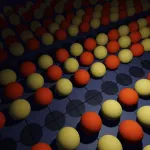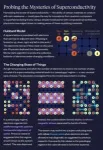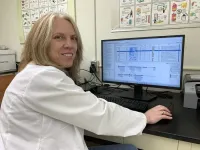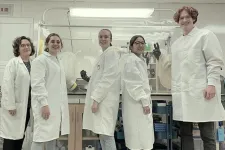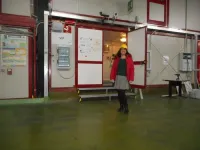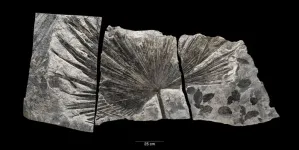(Press-News.org) By cleverly applying a computational technique, scientists have made a breakthrough in understanding the ‘pseudogap,’ a long-standing puzzle in quantum physics with close ties to superconductivity. The discovery, presented in the September 20 issue of Science, will help scientists in their quest for room-temperature superconductivity, a holy grail of condensed matter physics that would enable lossless power transmission, faster MRI machines and superfast levitating trains.
Certain materials involving copper and oxygen display superconductivity (where electricity flows without resistance) at relatively high — but still frigid — temperatures below minus 140 degrees Celsius. At higher temperatures, these materials fall into what’s called the pseudogap state, where they sometimes act like a normal metal and sometimes act more like semiconductors. Scientists have found that the pseudogap shows up in all so-called high-temperature superconducting materials. But they didn’t understand why or how it shows up, or if it sticks around as the temperature drops to absolute zero (minus 273.15 degrees Celsius), the unreachable lower limit of temperature at which molecular motion stops.
By better understanding how the pseudogap appears and how it relates to the theoretical properties of the superconductive materials at absolute zero, scientists are getting a clearer picture of those materials, says study co-author Antoine Georges, director of the Flatiron Institute’s Center for Computational Quantum Physics.
“It’s like you have a landscape and a lot of fog, and previously you could just see a few valleys and a few peaks,” he says. “Now the fog is dissipating, and we can see more of the full landscape. It’s really quite an exciting time.”
Quantum physicists can study states such as the pseudogap with computational methods that model the behavior of electrons in a material. But these computations are incredibly difficult because of quantum entanglement, in which electrons become connected and cannot be treated individually even after they separate. For more than a few dozen electrons, directly calculating the behavior of all the particles is impossible.
“Computing the properties of these materials is extraordinarily challenging — you can’t simulate them exactly on even the most powerful computer you can think of,” Georges says. “You have to resort to clever algorithms and simplified models.”
One famous model is called the Hubbard model: Researchers treat the material as a chessboard on which electrons can hop between adjacent spaces like a rook. Electrons can have either an upward or a downward spin. Two electrons can only share a space on the board if they have opposite spins and pay an energy cost. With this model, which originated in the 1960s, scientists can deploy different computational methods, each with strengths and weaknesses in different situations.
“There is a class of methods which work very well at zero temperature, and there is another class of methods which work very well at finite temperatures,” says Fedor Šimkovic IV, lead author of the new study, who was a postdoc with co-author Michel Ferrero at the École Polytechnique and Collège de France in Paris and is now a team lead at IQM Quantum Computers in Munich, Germany. “These two worlds don’t usually speak to each other because, in between them, at very low but finite temperatures, actually lies the computationally hardest regime.”
That in-between state is exactly where the pseudogap lives. To address that regime, the team applied an algorithm called diagrammatic Monte Carlo, which was first described in 1998; it was improved in 2017 by Riccardo Rossi, a co-author of the new paper. Unlike quantum Monte Carlo, a fruitful and well-known algorithm that uses randomness to examine small areas of the model at a time and glues together those examinations to reach conclusions, diagrammatic Monte Carlo considers interactions across the entire chessboard at once.
“The approach of diagrammatic Monte Carlo is very different,” says Rossi, a researcher at CNRS and Sorbonne University. “We can simulate, in principle, an infinite number of particles.”
Armed with diagrammatic Monte Carlo, the team figured out what happens to pseudogap materials as they cool down toward absolute zero. From previous research, they knew that the materials could start superconducting, or they could develop ‘stripes,’ in which the electrons organize into rows of matching spins separated by rows of empty squares.
Which state the Hubbard model enters at absolute zero depends on the number of electrons. When the model includes exactly as many electrons as chessboard squares, the entire board becomes a stable checkerboard pattern of up and down spins, making the material an electric insulator (deeply uninteresting for superconducting research, because insulators are the opposite of conductors). Adding or taking away electrons can cause superconductivity and/or stripes.
At higher temperatures, at which electrons still move around, researchers knew taking away electrons causes the pseudogap, but they didn’t know what happens as the material cools.
“It was debated if the pseudogap always evolves into the stripe state,” Georges says. “Our paper answers this prominent question in the field and closes that window.” The study revealed that, as materials in the pseudogap cool toward absolute zero, they do indeed develop stripes. Interestingly, Georges adds, tweaking the Hubbard model to allow diagonal moves, like a bishop’s, makes the pseudogap evolve into a superconductor as it cools.
The paper also answered the question of what causes the pseudogap, in which the electron arrangement is no longer uniform as it was at absolute zero but instead includes some stripy areas, some squares with two electrons, some holes, and some patches of checkerboard patterns. The researchers figured out that as soon as those checkerboard patches appeared in the electron arrangements, the materials fell into the pseudogap. These two big answers about the pseudogap help further untangle the Hubbard model.
“On a broader level, this whole thing is part of a collective effort across the scientific community of combining together computational approaches to crack open these difficult nuts,” Georges says. “We are living through times where finally these problems are getting clarified.”
These results will also benefit other applications beyond numerical calculations, including quantum gas simulation, a 20-year-old field at the intersection of quantum optics and condensed matter physics. In these experiments, atoms are cooled down to ultracold temperatures and then trapped by lasers into a grid akin to the Hubbard model. With new developments in quantum optics, researchers can now lower those temperatures almost to the point where the pseudogap forms, uniting theory and experiment.
“Our paper has a direct bearing on these ultracold quantum gas simulators,” Georges says. “These quantum simulators are now on the verge of being able to see this pseudogap phenomenon, so I’m expecting some really interesting developments in the coming year or two.”
About the Flatiron Institute
The Flatiron Institute is the research division of the Simons Foundation. The institute's mission is to advance scientific research through computational methods, including data analysis, theory, modeling and simulation. The institute's Center for Computational Quantum Physics aims to develop the concepts, theories, algorithms and codes needed to solve the quantum many-body problem and to use the solutions to predict the behavior of materials and molecules of scientific and technological interest.
END
Mysteries of the bizarre ‘pseudogap’ in quantum physics finally untangled
A new paper unravels the mysteries of a bizarre physical state known as the pseudogap, which has close ties to the sought-after state called high-temperature superconductivity, in which electrical resistance disappears.
2024-09-19
ELSE PRESS RELEASES FROM THIS DATE:
Study: Proteins in tooth enamel offer window into human wellness
2024-09-19
A new way of looking at tooth enamel could give scientists a path to deeper understanding of the health of human populations, from the ancient to the modern.
The method, published this week in the Journal of Archaeological Science, examines two immune proteins found embedded in human tooth enamel: immunoglobulin G, an antibody that fights infection, and C-reactive protein, which is present during inflammation in the body.
“These proteins are present in tooth enamel, and they are something we can use to study the ...
New cancer cachexia treatment boosts weight gain and patient activity
2024-09-19
Researchers discovered a drug that safely and effectively helped cancer patients when they suffered from cachexia (ku-KEK-see-uh), a common condition related to cancer that involves weight loss and muscle wasting.
The results of the randomized phase 2 clinical trial, which included187 individuals who experienced cachexia with lung, pancreatic, or colorectal cancer, were reported in the New England Journal of Medicine on Sept. 14, 2024. Richard Dunne, MD, MS, a Wilmot Cancer Institute oncologist and cachexia expert was part of the large group of investigators ...
Rensselaer researcher receives $3 million grant to explore gut health
2024-09-19
Blanca Barquera's investigation into the energy-generating processes of Bacteroides, the most abundant member of the gut microbiome, and their impact on our well-being holds the promise of significant advancements in human health. Barquera is a professor at Rensselaer Polytechnic Institute in the Departments of Biological Sciences and Chemistry and Chemical Biology.
In recent years, it has become increasingly clear that an unhealthy gut is more than just a source of digestive troubles. A healthy ...
Elam named as a Fellow of the Electrochemical Society
2024-09-19
Jeffrey Elam, senior chemist, Distinguished Fellow, and founder of the atomic layer deposition (ALD) research program at the U.S. Department of Energy’s Argonne National Laboratory, was named as a fellow of the Electrochemical Society (ECS), which focuses on advancing theory and practice at the forefront of electrochemical and solid-state science and technology. Elam, who has been with the lab since 2002, has been a trailblazer in thin film coating science and technology for over 20 years, ...
Study reveals gaps in access to long-term contraceptive supplies
2024-09-19
Oregon Health & Science University researchers have found that despite legislation in 19 states requiring insurers to cover a 12-month supply of contraception, patients aren’t receiving a year’s worth of their prescription; most receive just three months or less.
Their study recently published in the journal JAMA Health Forum shows that policies requiring coverage of a 12-month supply of short-acting hormonal contraception — most commonly the birth control pill — have not been fully implemented, resulting in no substantial increases nationally in year-long prescription orders. This leaves many patients at an increased risk for unintended ...
Shining a light on the roots of plant “intelligence”
2024-09-19
All living organisms emit a low level of light radiation, but the origin and function of these 'biophotons' are not yet fully understood. An international team of physicists, funded by the Foundational Questions Institute, FQxI, has proposed a new approach for investigating this phenomenon based on statistical analyses of this emission. Their aim is to test whether biophotons can play a role in the transport of information within and between living organisms, and whether monitoring biophotons could contribute to the development of medical techniques for the early diagnosis of various diseases. Their analyses of the measurements of the faint glow emitted by lentil ...
Scientists identify a unique combination of bacterial strains that could treat antibiotic-resistant gut infections
2024-09-19
Antibiotic-resistant bacterial infections often occur in patients with chronic inflammatory intestinal conditions, such as inflammatory bowel disease, and in patients who have taken antibiotics for a long time. Gram-negative bacteria such as Enterobacteriaceae are a common cause of these infections and have few treatment options. Fecal microbiota transplants have shown promise to curb some of these infections, but their composition varies between batches and they aren’t always successful.
Researchers at Keio University School of Medicine in Tokyo and the Broad Institute of MIT and Harvard have isolated ...
Pushing kidney-stone fragments reduces stones’ recurrence
2024-09-19
Sometimes all it takes is a little push.
That is the conclusion of a recently published study in which doctors used a handheld ultrasound device to nudge patients’ kidney-stone fragments.
As many as 50% of patients who have kidney stones removed surgically still have small fragments remaining in the kidneys afterward. Of those patients, about 25% find themselves returning for another operation within five years to remove the now-larger fragments.
UW Medicine researchers found, however, that patients ...
Sweet success: genomic insights into the wax apple's flavor and fertility
2024-09-19
A recent study has successfully decoded the autotetraploid genome of the wax apple, uncovering its genetic evolution and key factors driving fruit diversity. The research highlights the fruit’s rich antioxidant profile, with promising implications for human health and breeding strategies aimed at enhancing nutritional value.
Wax apple (Syzygium samarangense), known for its crisp texture, rose-like aroma, and health benefits, faces breeding challenges due to its complex genetic diversity and limited genomic data. These obstacles have hindered efforts to improve key fruit qualities such as size and sugar ...
New study charts how Earth’s global temperature has drastically changed over the past 485 million years, driven by carbon dioxide
2024-09-19
A new study co-led by the Smithsonian and the University of Arizona offers the most detailed glimpse yet of how Earth’s surface temperature has changed over the past 485 million years. In a paper published today, Sept. 19, in the journal Science, a team of researchers, including paleobiologists Scott Wing and Brian Huber from the Smithsonian’s National Museum of Natural History, produce a curve of global mean surface temperature (GMST) across deep time—the Earth’s ancient past stretching over many millions of years. ...
LAST 30 PRESS RELEASES:
Post-stroke injection protects the brain in preclinical study
Cardiovascular risk score predicts multiple eye diseases
Health: estimated one in ten British adults used or interested in GLP-1 medications for weight loss
Exercise to treat depression yields similar results to therapy
Whooping cough vaccination for pregnant women strengthens babies’ immune system
Dramatic decline in new cases of orphanhood in Uganda driven by HIV treatment and prevention programs
Stopping weight loss drugs linked to weight regain and reversal of heart health markers
Higher intake of food preservatives linked to increased cancer risk
Mass General Brigham–developed cholera vaccine completes phase 1 trial
First experimental validation of a “150-year-old chemical common sense” direct visualization of the molecular structural changes in the ultrafast anthracene [4+4] photocycloaddition reaction
Lack of support for people on weight loss drugs leaves them vulnerable to nutritional deficiencies, say experts
Dogs’ dinners can have greater climate impact than owners’
Are you ready to swap salmon for sprats and sardines?
1.6 million UK adults used weight loss drugs in past year
American College of Cardiology comments on new dietary guidelines for Americans
American Society of Gene & Cell Therapy and Orphan Therapeutics Accelerator partner to advance and commercialize promising rare disease treatments
One in 14 patients having day case surgery have new or worse chronic pain 3 months after their operation
New study highlights link between eviction rates and gun violence
Heatwaves heat up soil but not toxin levels in rice, study finds
Digital modeling reveals where construction carbon emissions really come from
Turning farm waste into water filters
New study shows how the spleen helps the immune system accept a transplant
New Mayo Clinic study advances personalized prostate cancer education with an EHR-integrated AI agent
Researchers identify novel therapeutic target to improve recovery after nerve injury
Microbes in breast milk help populate infant gut microbiomes
Reprogramming immunity to rewrite the story of Type 1 diabetes
New tool narrows the search for ideal material structures
Artificial saliva containing sugarcane protein helps protect the teeth of patients with head and neck cancer
Understanding the role of linear ubiquitination in T-tubule biogenesis
Researchers identify urban atmosphere as primary reservoir of microplastics
[Press-News.org] Mysteries of the bizarre ‘pseudogap’ in quantum physics finally untangledA new paper unravels the mysteries of a bizarre physical state known as the pseudogap, which has close ties to the sought-after state called high-temperature superconductivity, in which electrical resistance disappears.
